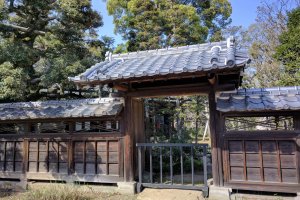Yoshida-Tei, an Edo Period house a little distance from Kashiwa City’s center, is an architectural treasure that will transport you to another time and a genteel way of life.
The estate was the home of the Yoshida family, the patriarchs of which have been village headmen in the area since the Heian Period. In the Edo Period, the family minded the shogun’s horse pastures, and gradually gained favor until they were granted the right to carry swords by the shogunate. They became influential traders, too, and started a soy sauce brewery. In the Taisho Period, their soy sauce brewery later moved to Noda City, contributing to the foundation of the Kikkoman Corporation.
The wealth of the family is attested to in the carefully preserved antique buildings on the estate. The Nagayamon, the great gate at the front, built in 1831, was the rice storehouse, with a capacity of 1000 bales of rice. In the courtyard is the Mukai-gura, a storeroom, is a good example of fire-resistant architecture of the period.
The main house, built in 1883, is the highlight of the visit. From the garden, visitors can admire the kayabuki yane, or thatched roof, which has been rebuilt for generations on a traditional pattern, creating sweeping curves in the eaves. From the earthen floored kitchen, the rafters are visible, and massive columns rise to the roof. An imposing daikoku, or main column, dominates the big living space, and the butsuma, the Buddhist altar, occupies a whole wall of the house. Besides the grand structure of the house, there are some charming small details. The carefully crafted hardware in the shape of oak leaves alludes to the name of the town, Kashiwa, which is the name of a variety of oak tree. Delicate transoms above sliding doors and decoratively window frames admit light and air, and relieve the heaviness beams of the dark wood interior. The original verandas which stretch along the front of the house are constructed from heartwood, with cross pieces that have prevented the decks from warping.
The garden, too, has some outstanding features. Massive stepping stones and statuary were crafted by skilled artisans from Tokyo, then Edo. The garden is beautiful in all seasons, but especially in spring when the cherry trees blossom, and in autumn when the fall foliage is at its best. It’s also a good place to take a break from the sweltering heat in the summer when the house is opened up to catch breezes under the massive roof.






























